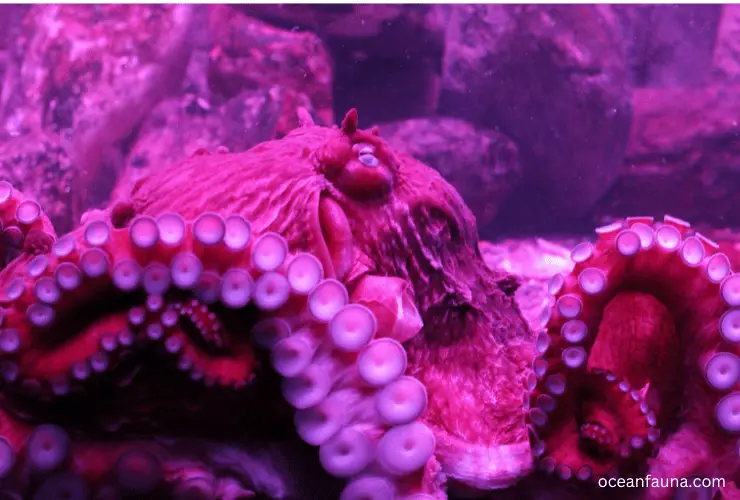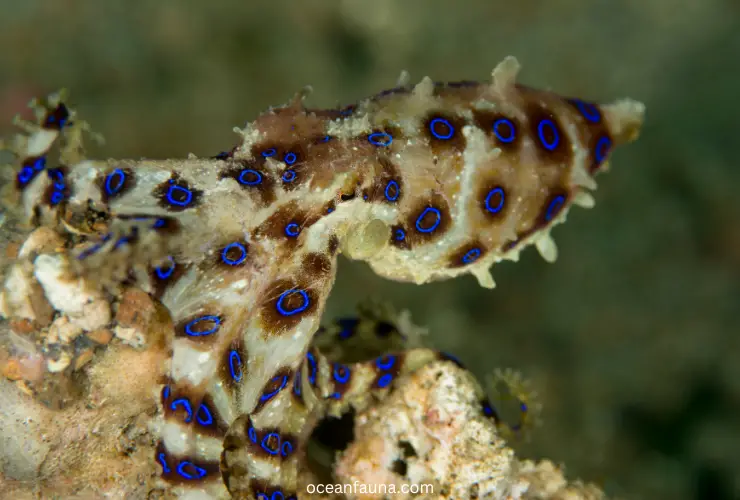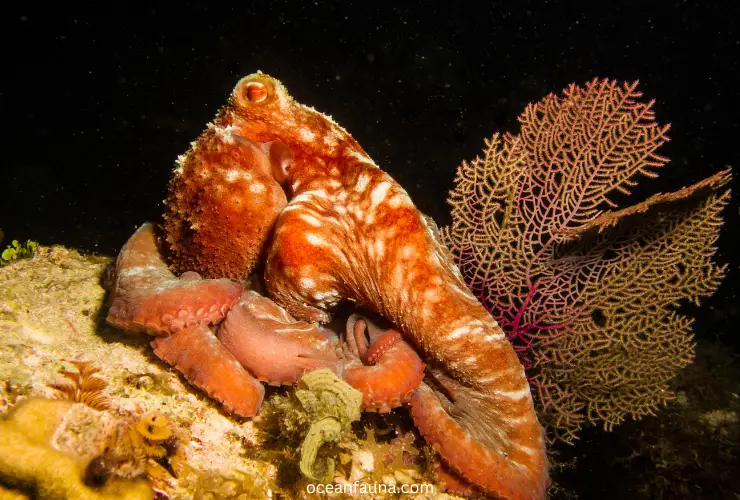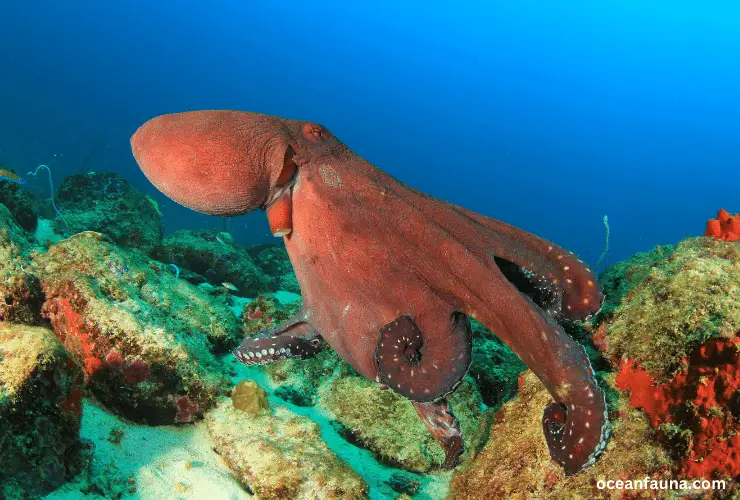Do you know that all cephalopods can change both their color and texture? Yes, all cephalopods have such ability. So, octopuses can also change color.
Now, you might have questions regarding how and why they do so. Don’t worry; here I will give you a detailed explanation of it. So read on.
Can Octopus Change Color?
Yes, octopuses have the remarkable ability to change color and texture in order to camouflage themselves and communicate with other octopuses. They accomplish this feat using specialized pigment cells in their skin called chromatophores, which contain different colored pigments and can expand or contract to alter the color of the skin.
Octopuses can also change the texture of their skin by manipulating tiny muscles located around the chromatophores. This allows them to create intricate patterns, mimic the texture of their surroundings, and even create the appearance of spikes or bumps on their skin.
In addition to camouflage, octopuses use color change as a means of communication and signaling.
For example, they may display bright colors as a warning signal or to attract a mate. They can also use color change to express their mood and respond to changing environmental conditions.
Can All Octopuses Change Color?

Yes, all octopuses possess the ability to change color. However, different species of octopus vary in their degree of color-changing capability. For example, some are very adept at blending into their environment and changing colors rapidly, while others are restricted to a few basic colors or can only display subtle changes in hue.
Whatever it is, all the octopuses can change their color regarding the situation. This is not only an incredible feat of evolution but also helps these creatures survive in their environment and interact with one another.
What Is It Called When an Octopus Changes Color?
When an octopus changes color, it is called a physiological color change or metachrosis. This fascinating process allows the octopus to blend into its environment and avoid predators or sneak up on prey.
The color change is not simply due to pigments in the skin but rather a complex system involving specialized cells called chromatophores and other structures called iridophores and leucophores.
The chromatophores contain sacs of pigment that can expand or contract, causing the skin to change color. The iridophores and leucophores, which contain reflective layers of crystals, can also contribute to the color change by reflecting light differently based on their orientation.
How Do Octopuses Change Their Color? [Detailed]
Octopuses change color using a complex mechanism involving the interaction between their skin and nervous system. The thousands of chromatophores located just beneath their skin are controlled by small muscles and nerves that enable the octopus to adjust the size and position of each sac containing the colored pigment.
When the octopus wants to change its color, it first sends a signal from its brain to its chromatophores, which then open or close their respective sacs depending on the pigment required. This mechanism allows the octopus to create a range of colors by mixing different pigments.
In addition to their chromatophores, octopuses have other cells, such as iridophores and leucophores, reflecting light and creating a shimmering effect. These cells and the chromatophores allow the octopus to create intricate patterns and textures that help it blend in with its environment or communicate with other octopuses.
The whole process of color change is incredibly fast and can occur within seconds, making it an effective defense mechanism against predators. By blending in with its surroundings or creating a distraction, an octopus can avoid being seen or attacked.
Why Do Octopuses Change Color? [Detailed]
There are several reasons why octopuses change their skin color, ranging from warning to camouflage and self-expression. Here are the details.
Warning
Octopuses primarily change their color to warn predators and other threatening animals. When they sense danger, they usually display a dark color pattern to scare away their threats.
Camouflage
One of the primary reasons why octopuses change their skin color is for camouflage. When an octopus feels threatened, it can blend into its surroundings by changing its skin color to match the background. This allows it to become almost invisible to predators, effectively offering an escape from danger.
For instance, if an octopus is hiding in a coral reef, it will change its skin color to match the colors of the reef, making it difficult for predators to detect.
Communication
Octopuses are known to use their skin color to communicate with their mates and potential predators. When an octopus is trying to court a mate, it will change its skin color, using bright colors to signal its intention.
On the other hand, when an octopus encounters a predator, it will change its skin color to a dull or dark color as a warning sign.
Self-Expression
Octopuses are unique creatures, and each one has its personality. They use their ability to change skin color to express their mood and display a range of emotions.
For instance, an octopus may turn bright red when angry or pale white when scared.
Thermoregulation
Octopuses also use their ability to change skin color to regulate their body temperature. When an octopus is too cold, it can change its skin color to become dark and absorb more heat from the sun.
On the contrary, when an octopus is too hot, it can change its skin color to become lighter, reflecting more light and heat from its body.
Why Does a Baby Octopus Change Its Color?

Baby octopuses change their color immediately after birth due to the stress of hatching. The octopuses’ chromatophores, which are cells that contain pigments, become activated in response to the stressful experience of hatching, causing them to fire and resulting in a color change.
This natural adaptation allows the baby octopuses to camouflage themselves and avoid potential predators, as they are still vulnerable and delicate at this stage of their lives.
The ability to change color is a crucial survival mechanism for octopuses throughout their lives, as they rely on camouflage to protect themselves from predators and hunt for prey.
How Fast Can Octopus Change Color?
Octopuses can change their color in mere milliseconds! Specifically, the process of color change in octopuses is achieved through the movement of specialized pigment cells called chromatophores in the skin.
These cells contain pigments that can be expanded or compressed, allowing the octopus to change its skin’s color and pattern.
Research has shown that octopuses can change the color of their skin in as little as 200 milliseconds, which is faster than the blink of an average human eye. This rapid change occurs through coordinated signals from the octopus’s nervous system to the chromatophore cells, causing them to expand or contract in response to the environment.
Additionally, octopuses can alter their skin’s texture and shape to match their surroundings, further enhancing their camouflage abilities.
Interestingly, octopuses do not have independent control over each chromatophore cell – instead, groups of cells are controlled collectively to achieve the desired color and pattern changes.
This coordination requires a high degree of neural processing and is a testament to the remarkable intelligence of these animals.
Do All Octopus Have Camouflage?
Yes, all octopuses can camouflage themselves as a defence mechanism. This remarkable ability allows them to blend into their surroundings, making it harder for predators to detect them.

As I discussed above, camouflage is achieved through the use of specialized skin cells called chromatophores, which enable octopuses to change the color and patterns of their skin in mere seconds.
Additionally, octopuses can change the texture of their skin by contracting or relaxing their muscles, enabling them to mimic the texture of their surroundings. This allows them to seamlessly blend into rocks, corals, and sponges, making them virtually invisible to predators.
Studies have shown that octopuses can even mimic the patterns of other animals, such as lionfish or flounders, to avoid detection and potential attacks.
FAQs
Can an octopus turn red?
Yes, an octopus can turn red. Now, when an octopus turns red, it can be a sign of anger or aggression. Specialized pigment cells called chromatophores, which expand and contract to reveal various colors, are what cause this change in color.
Why does an octopus turn white?
When octopuses feel threatened and feared, they release a hormone that triggers the contraction of their muscles, squeezing the pigmented cells and causing them to flatten and spread apart.
It opens up white sacs, which reflect and scatter light to make the octopus appear white. This behavior is a defense mechanism, helping the octopus blend in with its surroundings and escape potential predators.
Why do octopuses turn black?
To intimidate potential threats and scare off other animals to protect itself, an octopus will turn black to blend in with its darker surroundings and stand taller off the ground to appear larger and more formidable.
Conclusion
Now you know all detail about how and why octopus changes their color. If you still have any queries regarding their camouflage, let me know. I will answer them as soon as possible.


2 thoughts on “Can Octopus Change Color? [Explained]”